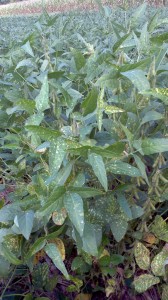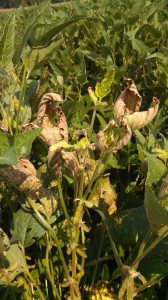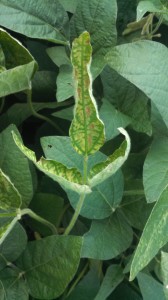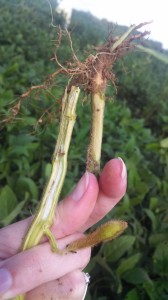Sudden Death Syndrome (SDS) has started showing up in soybean fields in Tennessee. The cool, wet season Tennessee has experienced, similar to last season, has been conducive for the disease to develop in susceptible varieties.
SDS is caused by the soilborne fungus Fusarium solani f. sp. glycines which produces a toxin that is translocated to the foliage resulting in the scattered, interveinal chlorotic spots in leaves (see images below). These spots may become necrotic (brown, dead tissue) or enlarge to form chlorotic (yellow) streaks that can become necrotic. Severely affected leaflets will usually detach from the petioles, leaving just the petioles attached to the plant. SDS leaf symptoms can look similar to southern stem canker, brown stem rot, and chemical burn. By examining the entire plant one can correctly identify SDS –after splitting the stem, the middle pith should be white, while the vascular tissue surrounding the pith will be discolored (image below), and there should not be any fungal development or cankers on the outside of the stem. If only foliage that had contact with a pesticide displays symptoms and new growth is unaffected, a pesticide burn is most likely the cause and not a disease. In a field, SDS affected areas usually show up in spots or scattered areas throughout the field (usually associated with low spots or areas of compaction), not uniform across a field (a uniform pattern across the field is more likely to be pesticide injury). Descriptions and pictures of other soybean disease symptoms and management options can be found at UTcrops.com (Soybean Disease and Nematode Identification Guide).
SDS is usually more severe in saturated soils, such as in low spots and under irrigation as opposed to non-irrigated fields. Other factors associated with SDS affected areas include high fertility and soil compaction. SDS is also more likely in soybean fields following corn, as corn is also a host for the pathogen. Furthermore, soybean cyst nematode (SCN) infestations can be associated with SDS and increase the effect on yield. It is best to take soil samples in the fall to check for SCN infestations to clearly identify all the possible pathogens affecting the field. More information on sampling and free testing for SCN can be found at UTcrops.com (Nematode Sample How To and Nematode Sampling Form).
Fields that develop SDS are likely to develop the disease during subsequent years when favorable weather conditions occur. So if there were fields that developed SDS last year, there is a good chance it will show up again this year in the same fields and spots. Management options include planting a resistant to moderately resistant variety – the majority of varieties tested by UT in 2013 in the variety performance tests were rated for SDS and can be found at UTcrops.com (Soybean Variety Trials). Specific tables that have SDS ratings in the publication include Tables 4 and 10 (Maturity group (MG) III), 14 and 20 (early MGIV), 24 and 30 (late MGIV), 34 and 40 (early MGV), 40 and 44 (late MGV), 51 and 57 (Liberty Link (LL) MGIV), 61 (LL MGV), 68 (conventional, LL, RR MGIV), 73 (conventional, LL, RR MGV). Some tables rate SDS as low, mod, or high; where fields highly affected by SDS should be planted in a low-only rated variety, similarly a variety with low disease index rating on other tables would be recommended in SDS affected fields. Other management practices include using cultivation practices that prevent or reduce soil compaction and improve drainage in low spots, and reducing soybean cyst nematode populations and not over fertilizing.







One thought on “Sudden Death Syndrome (SDS) in Soybean”
Comments are closed.